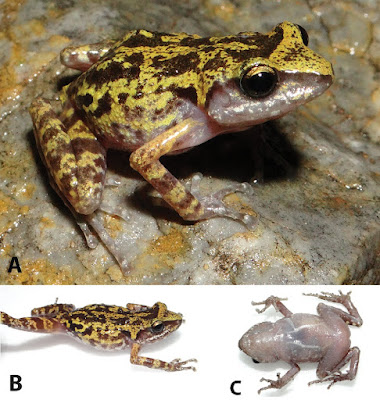 |
| Eleutherodactylus franzi Grünwald, Montaño-Ruvalcaba, Jones, Ahumada-Carrillo, Grünwald, Zheng, Strickland & Reyes-Velasco, 2023 |
Abstract
We describe a new species of Eleutherodactylus (subgenus Syrrhophus) from Guerrero, Mexico, based on morphological and molecular data, as well as advertisement call analysis. Eleutherodactylus franzi sp. nov. has unique features including widely expanded fingertips, indistinct, but visible lumbo-inguinal glands, an immaculate white venter and dark reticulations on a cream dorsal background colouration. The new species belongs to the Eleutherodactylus nitidus species group. Eleutherodactylus franzi sp. nov. is micro-endemic, restricted to a small range in karstic hillsides on the southern extreme of the Mexican Transverse Ranges. We discuss conservation needs of this species, which we provisionally classify as Critically Endangered.
Key Words: amphibians, Anura, conservation, Guerrero, Mexican Transverse Ranges, taxonomy
Diagnosis: Based on our phylogenetic analysis, this is a member of the genus Eleutherodactylus, subgenus Syrrhophus, as defined by Hedges et al. (2008). In the Eleutherodactylus (Syrrhophus) nitidus species series and the Eleutherodactylus (Syrrhophus) nitidus species group as defined by Grünwald et al. (2018), based on the condition of the tympanic annuli, ventral epidermis and visceral peritoneum. A small frog, but relatively large Syrrhophus, adult males measure 25.6–29.5 mm SVL; vocal slits are present in males, readily visible under partially translucent ventral epidermis; digital tips are widely expanded, 1.8–2.6 times the width of the narrowest part of the finger on the third and fourth fingers; fingers moderately long, finger lengths are I-II-IV-III with third finger length ranging from 15–18% of SVL; compact lumbo-inguinal gland above the inguinal region present, raised, indistinct, but visible in live specimen; ventral epidermis is partially translucent and visceral peritoneum is clear, not white, thus abdominal vein is not clearly visible against a white background on the venter of live specimens and viscera is partially visible through translucent dark grey ventral epidermis; limbs moderate, TL/SVL ratio is 0.40–0.50, FeL/SVL ratio is 0.31–0.38 and TotFL/ SVL ratio is 0.50–0.60; snout relatively short, END/ SVL ratio is 0.08–0.11; tympanum small, indistinct and round, tympanic annuli not visible in live specimen; TW/ED ratio is 0.40–0.60. The dorsal and lateral skin is slightly shagreened, whereas the ventral skin is smooth. Dorsal colouration cream or tan, with darker brown reticulations on dorsal and lateral portions of head and back; loreal and region dark brown, from snout to behind tympanum, with some pale spots and speckling present on labial region same colour as pale dorsal colouration; pale interorbital bar variable, may be present or absent, when present same colour as pale dorsal colouration of head and body; distinct irregular-edged dark brown transverse bands present on legs; upper arms same colouration and pattern as forearms; no pale mid-dorsal stripe; upper flanks same colour as dorsum, lower flanks whitish with some grey marbling; venter pale lavender with some sparse white spotting and pale grey on throat. No inguinal flash colours present on thighs and groin. The mating call of adult males is a short low-pitched pipe (see below; Fig. 4).
Etymology: This species is named after Héctor Franz-Chávez, Mexican herpetologist and avid field collector who collected the type material and who helped collect an extensive sampling of the Eleutherodactylus specimens to be used in our succession of studies.
Christoph I. Grünwald, Carlos Montaño-Ruvalcaba, Jason M. Jones, Iván Ahumada-Carrillo, André J. Grünwald, Jiacheng Zheng, Jason L. Strickland and Jacobo Reyes-Velasco. 2023. A Novel Species of Piping Frog Eleutherodactylus (Anura, Eleutherodactylidae) from southern Mexico. Herpetozoa. 36: 95-111. DOI: 10.3897/herpetozoa.36.e104707
Resumen: Describimos una especie nueva de Eleutherodactylus (subgénero Syrrhophus) de Guerrero, México basado en datos morfológicos y moleculares, así como análisis de llamadas de apareamiento. Eleutherodactylus franzi sp. nov. tiene características únicas, incluyendo puntas de los dedos ampliamente expandidas, glándulas lumbo-inguinales indistintas pero visibles, un vientre blanco inmaculado y una coloración dorsal de reticulaciones oscuras sobre un fondo crema. La especie nueva pertenece al grupo de especies de Eleutherodactylus nitidus. Eleutherodactylu. franzi sp. nov. es micro-endémica, restringida a un pequeño rango en laderas kársticas en el extremo sur del Eje Neovolcánico. Presentamos mapas de distribución y gráficos de llamadas de apareamiento de los machos de la nueva especie y sus parientes más cercanos, así como recomendaciones de conservación.
Palabras clave: anfibios, Anura, conservación, Eje Neovólcanico, Guerrero, taxonomía

